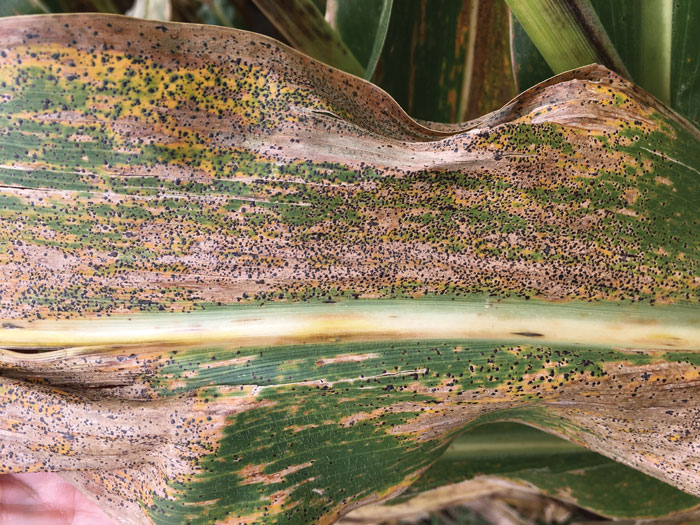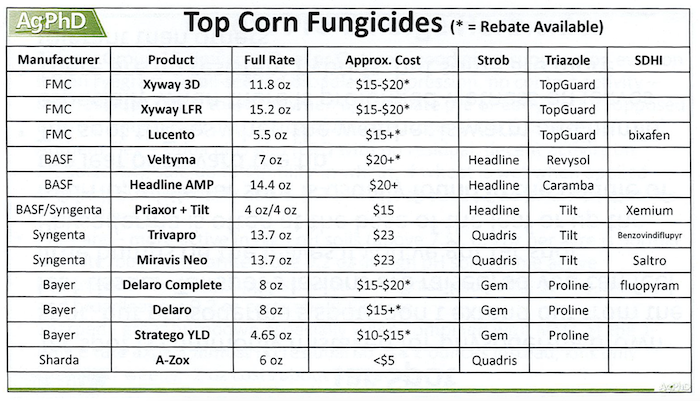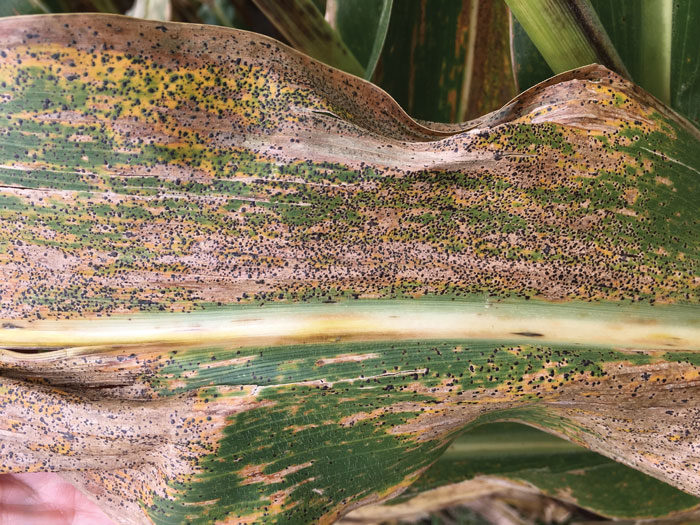At least 11 states in the U.S. have confirmed reports of tar spot in corn, according to the Crop Protection Network.
This map from the Crop Protection Network shows the counties with confirmed positives for tar spot. As of July 15, Indiana is having the widest outbreak with the Corn Belt states of Iowa, Missouri, Illinois, Michigan and Wisconsin also reporting positives in certain counties.
What is Tar Spot?

The raised black dots on the surface of this corn leaf are tar spot infection. The dots are fungal fruiting structures that severely interfere with photosynthesis. Photo: Corteva
Tar spot is a condition blamed on a fungal infection of Phyllachora maydis and has been known to cause yield losses of up to 60 bushels per acre in untreated fields. It appears as small, raised black spots stuck on and scattered across corn leaf surfaces. These fungal fruiting structures interfere with photosynthesis.
First noted in the U.S. in 2015, the disease spread rapidly across much of the Corn Belt, costing an estimated 241 million bushels of production between 2018 and 2020. The disease spread east and south, and research indicates Phyllachora species are capable of infecting other grasses and flowering plants.
Brian and Darren Hefty, fourth-generation farmers, agronomists and hosts of Ag PhD, warned farmers about tar spot at the 2024 Commodity Classic in Houston this spring. Darren says tar spot has come as far west as South Dakota, where the Heftys farm, but it came late enough in the year that it didn’t cause much of a problem. However, he says tar spot can cause yield losses of 30-50 bushels per acre.
“Tar spot thrives in whether it's warm and humid, especially when there's prolonged wetness on the leaves,” Darren says. “There aren't any resistant hybrids just yet, but I will say this. There is quite a difference in tolerance from one hybrid to the next, so choose wisely if tar spot is in your fields. It can overwinter in stalks and residue.”
Treating Tar Spot
During the growing season, no-tillers can apply fungicide to combat the disease. The Heftys recommend spraying corn twice with fungicide, once before tassel and then about 3 weeks later.
“We like the really early timing of V4-V6 in the dry areas,” Brian says. “BASF has been talking about this ‘5 feet, time to treat’ thing (V8-V12), but that is on the early side. In wetter areas, I'd probably spray for tar spot 1-2 weeks before tassel and then spray again about 3 weeks later.”
There are 3 main modes of action in the products on the market for tar spot: strobilurin, triazole and SDHI (succinate dehydrogenase inhibitor). Some fungicides have multiple modes of action, while others rely on one.

Darren and Brian Hefty compiled this table of corn fungicides for tar spot to compare each brand name’s mode(s) of action and approximate cost. “You’ve got a lot of choices,” Brian says.
“We're seeing a lot of folks that are tank mixing, building their own 2-3 modes of action product,” Darren says. “In some cases, you might be able to do it cheaper, but there are plenty of 3-ways that can be used.”
Tar spot has been affecting U.S. corn for less than a decade — a benefit for corn growers who are fighting the disease.
“One thing with tar spot that not many people are talking about is many diseases have built up tolerance to strobilurin products,” Brian says. “Tar spot hasn't even been around that long, so it hasn't built resistance. That's part of the reason why Veltyma is working really well because it's got a strob and a triazole in there.”
Darren says breaking down the residue faster will help prevent another tar spot outbreak next season. No-tillers can try biological residue breakdown products and cover crops.
“Brassica cover crops have shown to break residue down faster,” Darren says. “That could potentially lessen how much tar spot you're going to have.”
FMC Xyway can be used in-furrow for long-lasting protection, according to the Heftys, and they say it’s especially useful when planting in cold and wet conditions.
Darren says there are a lot of lookalike diseases to tar spot, and he recommends the Ag PhD Corn Diseases app when scouting to identify what’s affecting the corn plant. The app has photos of the disease symptoms to compare.
Related Content
Combat Tar Spot with Tolerant Hybrids, Timely Fungicide Applications
What to Look for in Tar Spots
Little Hope For Fungicide Late-Season Tar Spot Control







